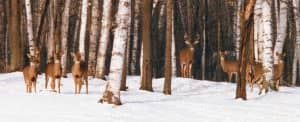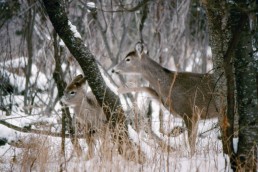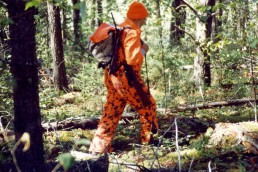Little-known Facts Every Whitetail Hunter Should Know part one
SHARE THIS POST
“I already know everything I need to know about how to hunt big bucks,” a teenaged lad once told me at a sports show. “Here’s proof,” he said, grinning as he pulled a photo from his shirt pocket. “I got this one last year. It scored 191 points. It’s going to be in the Boone and Crockett record book.”
“It certainly is a beauty,” I said, admiring his photo. “Few hunters are lucky enough to take one like this in a lifetime.”
“All you have to do to get one,” he explained, “is sit in a treestand. I’ve got a stand where I am going to get lots of them.”
Today, I’m sure this hunter realizes one big buck on the wall does not automatically make any hunter regularly successful at taking trophy-class bucks. An especially skilled and knowledgeable buck hunter might take 8 to 9 lesser bucks with antlers scoring 140 to 150 inches or more in 10 hunting seasons where deer numbers are optimal (like my son Ken), but I’ve never heard of anyone who has taken as near as many bucks that scored 170 or better in a lifetime. (170 inches is the minimum to qualify for the Boone and Crockett record book.)
There are lots of reasons.
For one, the largest of bucks (dominant breeding bucks) establish the largest of home ranges where they live spring, summer and fall (during hunting seasons). The largest bucks of forest regions establish home ranges about 1 square-mile (640 acres) in size with irregular perimeters. Some are 2 square miles in size. In intensely farmed regions their home ranges tend to be long and narrow, made up of a series woodlots and wooded river and stream bottoms and may be several miles long. Most deer hunters limit their hunting to only a mere fraction of a big buck’s home range, especially stand-hunters, making it easy for such bucks to avoid them.
Within the ranges of the largest bucks, are a number of smaller home ranges of other deer. Does with young generally have home ranges averaging about 125 acres in size and lesser bucks 2 1/2 to 3 1/2 years of age have home ranges up to about 1/2 square miles. In forest regions, doe ranges do not overlap, but buck ranges overlap considerably with ranges of does and other bucks. Four or five does with young (fawns and yearlings) and 3 to 5 lesser mature bucks are typically found living within most square-mile ranges of dominant breeding bucks (the largest of bucks) where deer numbers are optimal and habitat is suitable. What this means is, though about 40 percent of whitetails almost everywhere are antlered bucks, including yearlings, fewer than 10 percent of these bucks are likely to have “Boone and Crockett” antlers. Accordingly, Boone and Crockett bucks are relatively rare and always will be.
Are you enjoying this post?
You can be among the first to get the latest info on where to go, what to use and how to use it!
Contrary to wishful thinking, there is only likely to be one buck with record-book-class antlers in any 1- to 2-square-mile buck home range during any one year (not likely during every year). By mid-October such a buck has vanquished all other antlered bucks in battle that live in its home range, after which it will not allow them to remain within its range until breeding ends in the latter half of November. At other times 3–5 mature bucks, 2-1/2 to 6-1/2 years of age with lesser antlers (few wild bucks survive their seventh winter) will be found living within a big dominant buck’s range. According to the accustomed way of thinking by such bucks there simply isn’t room for additional mature bucks to live within their home ranges. Newcomers two years of age, and others searching for their first home ranges in spring, are forced by older bucks to seek home ranges elsewhere. Similarly, does with established home ranges force does two years of age or older (younger if pregnant) to find new home ranges of their own elsewhere. Only where fenced in or only in intensely farmed regions where suitable forest habitat is limited and whitetails are abundant or over-abundant in wooded habitat after crops are harvested are you likely to find more than one buck with Boone and Crockett antlers in a 1– to 2-square-mile area. Except in intensely farmed areas where whitetails have grown accustomed to crowding in late fall and winter, there is little, if anything, humans can do to make wild mature bucks or does share their home ranges with other mature bucks or does. Turn 12 of the record book bucks loose in a square-mile area, and soon they will be spread out in an enormous area (likely 100 square miles or more in size), with each superior buck establishing or pirating from lesser bucks’ widely separated individual home ranges with the best elements for survival, thus making themselves scarce in any one area.
Compounding the illusion there are too few trophy-class bucks in our deer-hunting areas these days, is the uncanny ability of today’s older bucks to avoid discovery by hunters during hunting seasons. Wild bucks most likely to have record-book antlers are 4 1/2 to 6 1/2 years of age. Unlike many other bucks, these particular bucks have survived multiple hunting seasons per year (archery, firearm and muzzleloader) for 4 1/2 to 6 1/2 years, mostly via their own, through superior wiles and efforts. Traditional hunting methods and tactics that enable hunters to more regularly take antlerless deer and yearling and 2 1/2-year-old bucks seldom enable hunters to see even these very experienced older bucks, much less take them.

Most of the deer trails found within these square-mile ranges are made and regularly used by small herds made up of does with young within their individual 125-acre ranges (yearlings normally remain in their mothers’ ranges throughout their yearling year). These trails are actually tunnels through cover over well-worn paths created by repeated use, becoming relatively silent passageways. Mature bucks—being loners throughout spring and summer—make few well-worn passageways of their own. Whereas they do often use doe trails, bucks 3 1/2 to 6 1/2 years of age are much larger (taller and wider) than does and other deer and commonly have antlers much wider than their bodies, making it difficult to travel silently on narrow doe trails in dense cover. For this reason, bucks of these ages often travel off-trail, typically more than 50 percent of the time during hunting seasons, making their movements even less predictable.
During any one day of a hunting season, dominant (breeding) bucks and most other deer utilize trails and bedding and feeding areas in only about 10 percent of their home or breeding ranges—typically long and narrow and commonly donut-shaped. The trouble is the 10 percent they use often changes from day to day, especially during hunting seasons. Movements of dominant bucks primarily depend on which does in their ranges are currently in heat. About 10 to 12 percent of does are in heat on any one day during the primary breeding period in November and lesser numbers are in heat during the two additional periods of breeding in December and early January. Like all other deer, their movements also depend on current weather conditions, especially wind direction, and discovered locations of hunters.
Whether scouting pre-season or hunting, the aforementioned makes it difficult for average hunters to determine which trails are or will be favored by mature bucks or other deer, and which stand sites (if several are selected and prepared preseason) might provide the best odds for hunting success on any one day.
Next month’s issue: Part two, and more eye-opening facts.
Dr. Ken Nordberg has written more than 700 magazine articles and 12 books on the habits and hunting of whitetails and black bears, including the “Whitetail Hunters Almanac” series. He also produced “Doc’s Buck and Bear Hunting School” videos. His encyclopedic website is at drnordbergondeerhunting.com.
MWO
SHARE THIS POST
Did you enjoy this post?
You can be among the first to get the latest info on where to go, what to use and how to use it!
Dr. Ken Nordberg
Based on his 55 years of field research, Dr. Ken Nordberg has written more than 800 magazine articles, 12 books on whitetails—including the famous Whitetail Hunter’s Almanac series—five books on black bear hunting and produced Buck and Bear Hunting School videos. You may peruse his encyclopedic website with whitetail hunting tips: drnordbergondeerhunting.com, his blog: drnordbergondeerhunting.wordpress.com, or social media pages.



